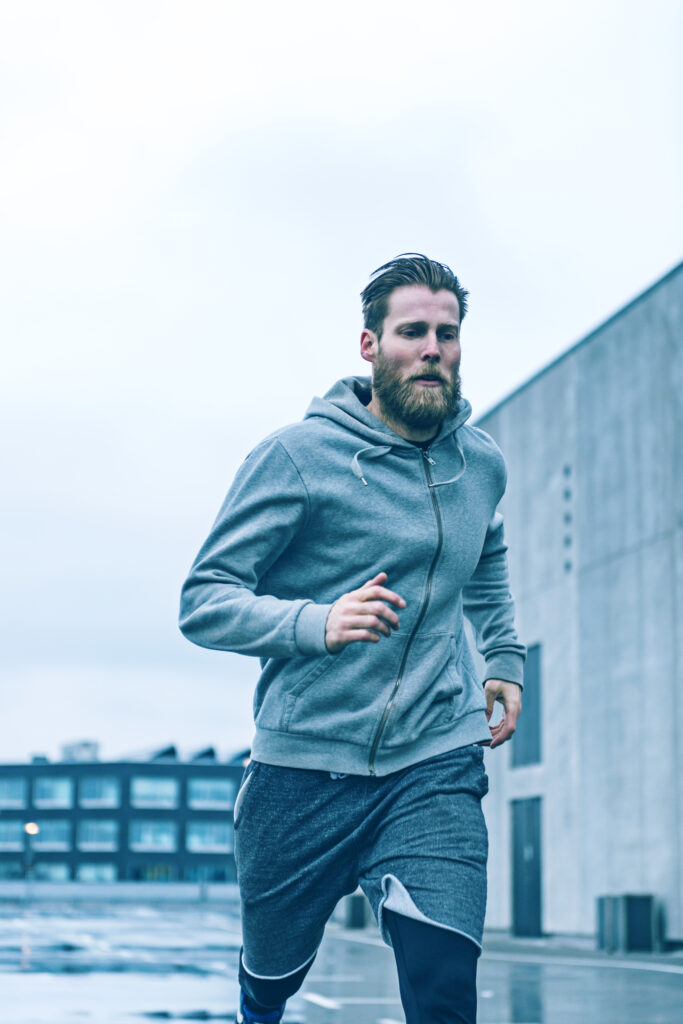
Consumers, brands, and retailers alike already appreciate cotton for its comfortable feel and classic look, but advances in technology are also enhancing cotton’s performance in moisture management, durability, and environmental impact.
Cotton is a durable, natural fiber with superior breathability and comfort. Three proven innovations – TOUGH COTTON™, STORM COTTON™, and TransDRY™ technologies – are bringing modern solutions to cotton’s tried-and-true marketability, enhancing its performance in the active, outdoor, workwear, children’s apparel, and lifestyle sectors.
“This suite of technologies allows cotton to provide moisture management, water repellency, or help enhance the durability of the fabric to compete with synthetic fibers,” says Katie Crumpton, executive account manager at Cotton Incorporated. “You get the comfort of cotton but with added performance.”
On top of performance innovations, the cotton industry is rapidly evolving to incorporate best sustainability practices and phase out chemical formulations that may impact health and safety. Cotton not only leads the way in developing clean chemistry solutions, but also works with its mills and suppliers to adopt these environmentally friendly solutions. “We’re always looking at what’s next or on the horizon to stay relevant to what’s most important to brands’ sustainability and chemistry goals,” says Marissa Simms, executive account manager at Cotton Incorporated.
TOUGH COTTON™, STORM COTTON™, and TransDRY™ technologies each hold strong in their respective markets for the performance, durability, and quality that brands and consumers have come to expect from cotton. Let’s take a closer look at how these technologies have evolved to offer superior cotton products throughout the apparel sector.

TOUGH COTTON™ Technology for Durability and Longevity
TOUGH COTTON™ technology combats wear and tear through the use of innovative cotton treatments. All fabrics degrade over time due to use and laundering, leaving them faded and more prone to tearing. TOUGH COTTON™ fabrics counteract this normal wear and tear to create garments that last. Yarns, fabrics, or garments treated with the technology feature a proprietary combination of abrasion resistance, strength, and colorfastness.
“Consumer insights tell us that cotton T-shirts and denim are the garments people keep in their closets the longest,” says Simms. “Showing us that cotton is an inherently durable fiber on the market. The TOUGH COTTON™ technology gives brands an opportunity to expand the range of long-wearing garments consumers invest in as their go-to pieces.”
TOUGH COTTON™ technology is a popular fabrication in the workwear, outdoor, and children’s apparel categories. Many major retailers have adopted TOUGH COTTON™ technology for kids’ leggings and sweatpants, which tend to wear out quickly in the knees without advanced reinforcement technologies. In fact, 75 percent of parents are willing to pay more for children’s clothing with durability enhancement.[1]
Similarly, TOUGH COTTON™ technology is a top-performing choice for camping and hiking apparel, with proven abrasion resistance against rocks, trees, and other natural hazards. TOUGH COTTON™ fabric is over two times stronger against abrasions and tearing compared to untreated cotton[2].
TOUGH COTTON™ finish is available as a yarn, fabric, or garment application and can be formulated with or without resin, depending on the product needs. Without resin, TOUGH COTTON™ technology uses a proprietary blend of softeners and crosslinking agents to balance durability with wearability; this formulation retains the softness, hand feel, and sewability of traditional cotton fabric. Woven fabrics from lightweight twills to heavy-duty canvas can resist snags, tears, and rips on the hiking trail or job site with TOUGH COTTON™ technology.
With resin, TOUGH COTTON™ technology creates flexible bonds to improve fabric strength and durability with the added benefit of superior wrinkle resistance. Unlike durable press technologies that feel brittle and weaken fabric over time, TOUGH COTTON™ fabrics remain both comfortable and supple, so you’ll look sharp and feel great, too. Both finishes will last the full life of the garment.
STORM COTTON™ Technology for Comfortably Weathering the Elements

Designed to hold up against the elements, STORM COTTON™ technology is another unique cotton performance solution. This innovative technology allows brands to get the benefits of maximum water resistance combined with cotton’s incredible comfort and breathability. For rain, snow, or a day on the water, this technology is a durable water-repellent (DWR) finish that keeps wearers cool, dry, and comfortable.
STORM COTTON™ technology repels moisture from the surface of fabric, drying faster than untreated cotton and shielding garments from the deteriorating effects of wet weather. STORM COTTON™ technology allows for air flow and transfer of moisture vapor to keep the wearer dry.
Despite its effectiveness at locking out moisture, STORM COTTON™ fabric doesn’t trap heat like many other synthetic DWR finishes. What’s more, its finish won’t degrade over time like its competitors; STORM COTTON™ fabric’s repellency lasts the life of the garment. [3]
STORM COTTON™ formulation offers versatile application options, depending on the needs of your suppliers. It can be applied directly to fabric or finished garment.
“One of the great benefits of STORM COTTON™ technology is that it allows consumers to shed traditional outerwear (think stiff raincoats or snow gear) for the comfort and ease of the cotton garments they already love,” Crumpton says.
“Fleece sweatshirts and hoodies are the dominant brand category for this technology. Say you’re commuting to work, out skateboarding, playing basketball, or hunting — whatever it is, you still get that water-repellent finish with a [simple] fleece sweatshirt,” Crumpton says. Other popular STORM COTTON™ applications include canvas jackets and denim wear.
STORM COTTON™ technology uses clean chemistry – an alternative to the use of standard perfluorinated molecules that do not break down as quickly in the environment. With this technology, performance is not sacrificed and spray repellency ratings are still able to be met, while providing a sustainable industry solution for a durable water repellent finish.

TransDRY™ Technology for Sweat-wicking and Odor Resistance
TransDRY™ technology is an exciting innovation that lets consumers enjoy the comfort they expect from cotton in their activewear . Because cotton absorbs moisture, it can get weighed down by sweat during a hard workout. Historically, cotton has been overlooked in the activewear market in favor of synthetics like polyester. But TransDRY™ technology has set a new standard in the industry.
With its patented moisture-management technology, it wicks sweat, dries faster, and keeps wearers comfortable and odor-free.
“We pride our technologies on being able to go from the gym to lunch to run your errands,” says Crumpton. “It’s breathable, it’s going to dry faster, and it’s going to wash clean.”
With TransDRY™ technology, cotton yarns are treated with a special process to make them water-repellent. As moisture moves along those channels, its surface area increases, leading it to dry in about half the time”, says Crumpton.
There are several different engineering methods to achieve that moisture-wicking result; the fabric can be constructed to move moisture horizontally, vertically, or from the inside out, pulling moisture away from the skin and onto the surface of the garment where it can dissipate easily into the air.
“TransDRY™ technology has been adopted by several major activewear brands. That’s where we see the most traction,” says Simms. “Its most common fabrication is in knit tops – T-shirts and tanks – that create a base layer next to your skin.”

Dual Technologies Further Elevate Cotton’s Performance
Many of cotton’s performance technologies have evolved to be used in conjunction with each other: TOUGH COTTON™ technology works with both STORM COTTON™ and TransDRY™ finishes, for example.
Combining the performance attributes of multiple technologies truly allows cotton to outcompete other fibers on the market. As the market demands more natural and sustainable options for consumers, cotton is ideally positioned to meet the needs of many brands and retailers.
“People are asking for more natural options, so a lot of companies are trying to get away from synthetic fibers,” says Simms, citing cotton’s popularity among consumers for its breathability, durability, and comfort. “But if they’re a performance brand, whether that be a fitness performance brand, workwear brand, or traditional outdoor brand, they still need to offer technology solutions so that cotton can compete with the synthetic products they’ve grown their business on.”
Cotton Remains a Consumer Favorite
Consumers trust cotton to meet their performance needs, remain strong and odor-free over the life of a garment, and fulfill their sustainability goals. Over 90% of consumers say that garments made from all-natural fibers such as cotton are better quality, and 73 percent say cotton/cotton blend is their favorite fiber to wear[4]. 58 percent of consumers prefer activewear made of cotton, listing comfort, breathability, and softness as top factors considered when buying activewear [5].
Performance-enhancing technologies including TOUGH COTTON™, STORM COTTON™, and TransDRY™ technologies ensure cotton remains a top choice for consumers in a changing marketplace, and makes good on its promise of durability, quality, and sustainability.
For more information on cotton’s performance technologies, contact your Cotton Incorporated account executive.
[1] Cotton Incorporated’s 2021 Lifestyle Monitor™ Survey
[2] ASTM D4966 – MODIFIED MARTINDALE ABRASION METHOD USING 3M TRIZACT PAD FOR KNITS
[3] AATCC TM 22: Spray Test for Repellency.
[4] Cotton Incorporated’s 2023 Lifestyle Monitor™ Survey
[5] CCI & Cotton Incorporated’s 2022 Global Activewear Study